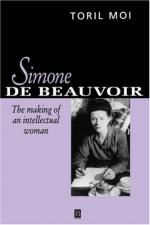|
This section contains 8,314 words (approx. 28 pages at 300 words per page) |

|
SOURCE: "La Langue brisée: Identity and Difference in de Beauvoir's La Femme rompue," in French Forum, Vol. 15, No. 1, January, 1990, pp. 73-92.
In the following essay, McNeece identifies the role language plays in the sufferings of Beauvoir's women protagonists in the collection The Woman Destroyed.
Simone de Beauvoir's death in 1986 refocused attention on one of France's most admired yet controversial figures. Long identified as Jean-Paul Sartre's amenuensis, and thus intellectually bound to existential humanism, de Beauvoir eventually came to occupy a very particular ideological space in French culture. Rarely has an individual—woman or man—elicited such extremes of feeling and opinion. But rarely has anyone embodied so completely the diverse faces of a society in transition as has she. It has been said that de Beauvoir represented all sides of the deep-seated conflicts that erupted in 1968. Having inaugurated a pragmatic feminist outlook in 1949 with Le Deuxième...
|
This section contains 8,314 words (approx. 28 pages at 300 words per page) |

|


